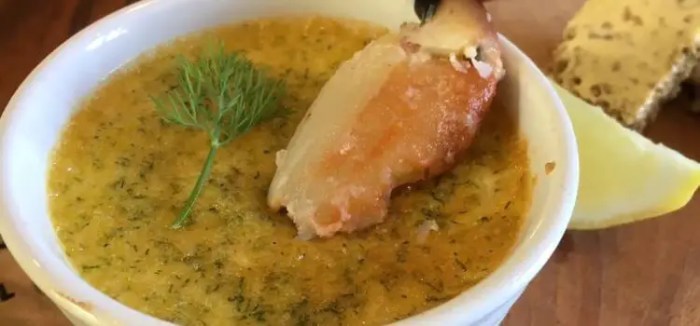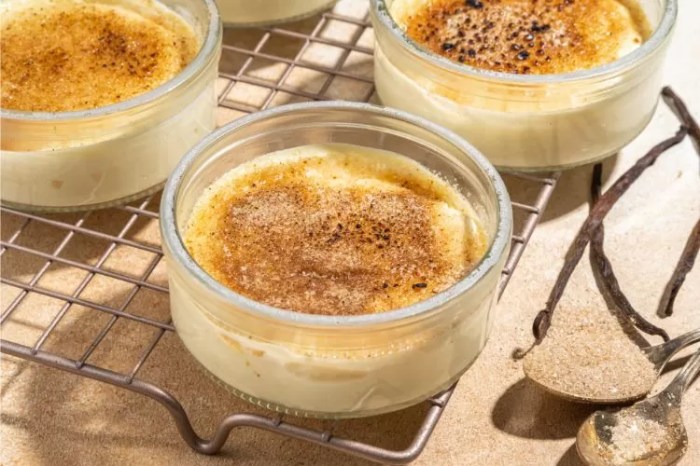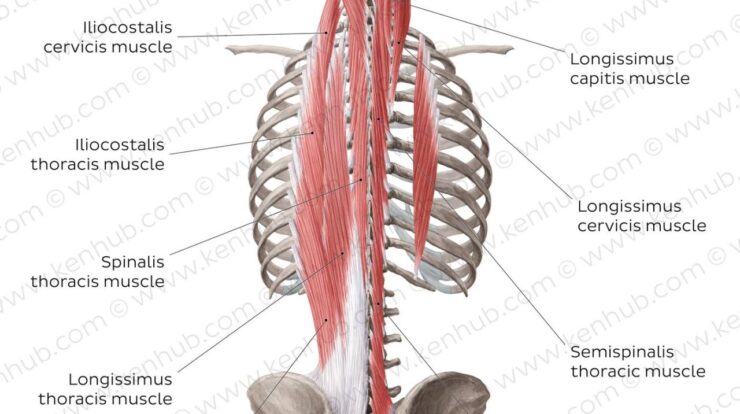
Embark on a culinary adventure with our tantalizing crab brulee recipe, a masterpiece that tantalizes taste buds and captivates the senses. This delectable dish seamlessly blends the delicate sweetness of crab with the rich, creamy indulgence of a brulee, creating an unforgettable gastronomic experience.
From the meticulously selected ingredients to the intricate preparation techniques, every aspect of this recipe has been carefully crafted to deliver a symphony of flavors and textures that will leave you craving more.
Ingredients and Preparation: Crab Brulee Recipe

Indulge in the exquisite flavors of crab brulee, a culinary masterpiece that combines the delicate sweetness of crab with the velvety richness of a custard. To create this extraordinary dish, you’ll need the finest ingredients and a meticulous approach to preparation.
The foundation of this recipe lies in fresh, succulent crab meat. Choose jumbo lump crab for its large, tender pieces that will melt in your mouth. Enhance the crab’s natural sweetness with a touch of Dijon mustard, adding a subtle piquancy that complements the seafood’s delicate flavor.
Eggs and heavy cream form the base of the custard, providing a rich and velvety texture. The addition of Parmesan cheese adds a nutty depth of flavor, while a hint of cayenne pepper brings a subtle warmth that awakens the palate.
Preparation
Begin by gently sautéing the crab meat in a touch of butter until it becomes opaque. Stir in the Dijon mustard and set aside to cool.
In a separate bowl, whisk together the eggs, heavy cream, Parmesan cheese, cayenne pepper, and salt. Pour the egg mixture over the crab meat and stir until well combined.
Transfer the mixture into individual ramekins and place them in a water bath. Bake at 325°F (163°C) for 25-30 minutes, or until the custards are set but still slightly wobbly.
Allow the crab brulees to cool slightly before serving. Garnish with fresh herbs or a drizzle of olive oil for an elegant touch.
Cooking Techniques
The crab brulee recipe utilizes a combination of baking and steaming to achieve its unique texture and flavor. Baking provides a gentle and even heat that cooks the crab meat thoroughly while preserving its delicate flavor. Steaming introduces moisture to the dish, ensuring that the crab remains moist and succulent.
Baking
Baking is a fundamental cooking technique that involves exposing food to dry heat in an enclosed environment, typically an oven. In the crab brulee recipe, baking is used to cook the crab meat through and create a golden-brown crust on top.
The optimal temperature for baking the crab brulee is 350°F (175°C), and the cooking time will vary depending on the size and thickness of the crab meat.
Steaming
Steaming is a cooking technique that involves exposing food to moist heat, typically by placing it over boiling water or in a steamer basket. In the crab brulee recipe, steaming is used to introduce moisture to the dish and prevent the crab meat from drying out.
The optimal temperature for steaming the crab brulee is 212°F (100°C), and the cooking time will vary depending on the size and thickness of the crab meat.
Specialized Equipment
No specialized equipment is required for the preparation of crab brulee. However, a baking dish, steamer basket, and oven are essential for the cooking process.
Presentation and Garnish

Elevate the visual appeal of your crab brulee by incorporating elegant presentation techniques. Consider using ramekins or individual serving dishes to create a sophisticated and personal dining experience.
Enhance the dish’s aesthetics with carefully chosen garnishes and accompaniments. Fresh herbs like chives or dill add a vibrant pop of color and subtle herbaceous notes. A drizzle of truffle oil or a sprinkle of toasted breadcrumbs adds richness and complexity to the dish.
Plating Options
Showcase the flavors and textures of your crab brulee through thoughtful plating. Arrange the ramekins on a serving platter adorned with edible flowers or microgreens for a touch of elegance.
Alternatively, consider creating a layered presentation. Place a layer of crab brulee in a clear glass or dish, followed by a layer of fresh greens or pickled vegetables. Top with a dollop of crème fraîche or a drizzle of balsamic reduction to add height and visual interest.
Variations and Adaptations
The classic crab brulee recipe offers a delectable combination of flavors and textures. However, there’s ample room for creativity and customization to suit various palates and dietary needs.
Incorporating Different Flavors and Ingredients
- Swap out crab for other seafood options like shrimp, lobster, or scallops.
- Add a touch of heat with diced jalapenos or cayenne pepper.
- Enhance the richness with sautéed mushrooms or chopped artichokes.
- Incorporate fresh herbs like dill, parsley, or tarragon for a burst of flavor.
- Experiment with different cheeses, such as Parmesan or Gruyere, to create a unique cheesy crust.
Adapting for Dietary Restrictions
- Gluten-free:Use gluten-free bread crumbs or cracker crumbs for the crust.
- Vegetarian:Replace the crab with roasted vegetables, such as zucchini, bell peppers, or mushrooms.
- Dairy-free:Opt for plant-based milk and cheese alternatives.
Creative Uses for Leftover Crab Brulee
- Top a fresh green salad with crumbled crab brulee for a savory crunch.
- Spread it on toasted bread or crackers as an elegant appetizer.
- Incorporate it into a creamy pasta sauce for a seafood-infused delight.
- Mix it with mayonnaise and chopped celery to create a unique crab salad.
- Use it as a filling for savory crepes or omelets.
Historical and Cultural Context

Crab brulee is a modern dish with a relatively short history, emerging in the early 21st century. Its origins can be traced to the popularization of molecular gastronomy and the desire to create innovative and visually appealing dishes.
While the exact origins of crab brulee are unknown, it is believed to have been developed by chefs experimenting with different ways to prepare crab. The combination of creamy crab custard with a caramelized sugar topping proved to be a hit, and the dish quickly gained popularity in fine dining establishments.
Regional Variations
As crab brulee gained popularity, chefs began to experiment with different regional variations. In the United States, crab brulee is often made with blue crab, while in Europe, brown crab is more commonly used. Other variations include the use of different cheeses, herbs, and spices.
Evolution and Influence, Crab brulee recipe
Crab brulee has had a significant influence on contemporary cuisine. Its popularity has led to the creation of other brulee dishes, such as lobster brulee and shrimp brulee. The dish has also inspired chefs to experiment with other ways to prepare crab, such as crab soufflé and crab ravioli.
Closure
Whether you’re a seasoned chef or a culinary novice, this crab brulee recipe will ignite your passion for cooking and leave an everlasting impression on your palate. So gather your ingredients, prepare your palate, and let’s embark on a culinary journey that will redefine your dining experiences.
FAQ Overview
What is the secret to achieving the perfect crab brulee texture?
The key lies in carefully controlling the temperature and cooking time. Overcooking can result in a rubbery texture, while undercooking can leave the dish raw. Trust your instincts and keep a close eye on the brulee as it cooks.
Can I use other types of seafood in this recipe?
Absolutely! Feel free to experiment with different seafood options, such as shrimp, lobster, or scallops. Each type of seafood will impart its unique flavor and texture to the dish.
How can I make this recipe gluten-free?
To make this recipe gluten-free, simply substitute gluten-free breadcrumbs for the regular breadcrumbs in the topping. You can also use a gluten-free flour blend in the batter.





